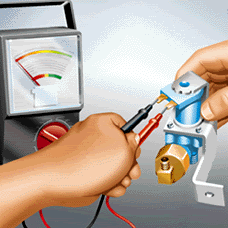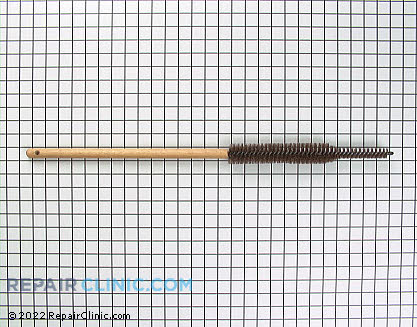Refrigerator and Ice Maker Maintenance
We’re trying out a new concept for a newsletter here in Samurai-land. In
addition to the quarterly (or so) full-blown newsletter with lots of
diverse information, we’re going to experiment with a monthly, shorter
issue that focuses on scheduled preventative maintenance tips for specific
appliances. Let us know whatcha think. If it’s not useful to you, then
please lemme know ‘cuz, if that’s the case, then I’d rather be out hiking
in the mountains instead of playing tippety-tap on the keyboard.
This being early Spring, we usually start getting lots of refrigerator and
ice maker service calls. Here are some things you can do that may help
avoid a service call on these cold appliances.
Refrigerator or stand-alone Freezer
Manual Defrost Refrigerator or Freezer
On manual-defrost refrigerator/freezers, check for frost build up in the
freezer. If there’s more than half an inch, it’s time for a defrosting.
Remove all the food, unplug the unit, and block open the door to let all
the frost melt. On upright units, this can make a wet mess on the floor so
put some towels down. On chest freezers, there will either be a drain or
all the water will collect in the bottom and can then be sponged out.
NEVER ever even think about using a putty knife or any kind of sharp metal
to scrape the frost off. It is very easy to puncture the evaporator and
ruin the refrigerator. Ain’t no going back from that one, Hoss.
Automatic Defrost Refrigerator or Freezer
On self-defrosting refrigerator/freezers, clean the drain pan underneath
the refrigerator that collects water (Some are not accessible. Don’t worry
if you can’t find yours). No need to go crazy, just wipe out the dog hair
and dried gookus so you don’t get a scum floatilla with stinkus when the
flood of condensate starts with the more humid weather.
Clean the refrigerator cooling fan and the condenser coils. The coils are
underneath the refrigerator. They are usually black and look like a series
of small tubes and “fins” connecting the tubes. Order a refrigerator
condenser brush to make the job easier: http://fixitnow.com/?p=6234
Check the door seals to be sure they are sealing properly against the frame
of the refrigerator/freezer. While you can get by with weak seals during
the colder, dryer winter months, they’ll let in lots of heat and moisture
during the humid, warm summer months and cause all kinda weird problems
inside the box. Do the Federal Reserve Note test: take your favorite
Federal Reserve Note and close the door on it, then give it a tug. Should
require some tension to pull it out. If not, that’s a weak spot in the
gasket. Do this all the way around the both doors.
If the gaskets are torn, or don’t seal properly, the refrigerator or
freezer may not cool properly. You may also start seeing frost formations
in weird locations inside the beer compartment or the freezer. This
problem is worse when the weather is warmer and more humid. Clean the
gaskets and frame with warm soapy water so they don’t stick to the frame.
Inspect the back wall of the freezer for any frost build up. It’s not
normal to have any frost on the back wall or floor of a self-defrosting
appliance. The presence of frost is normally an indication the
self-defrosting system has a problem. You can remove the back wall inside
the freezer to get some eyeballs on the evaporator coil. This page will
help you interpret what you see: http://fixitnow.com/?p=6036
For help troubleshooting warm refrigerator problems, use our warm
refrigerator flowchart: http://fixitnow.com/?p=4296
Ice Maker
If you have a built-in ice/water filter, replace the filter approximately
every six months. If you don’t have a water filter, and you find your ice
tastes bad and/or smells funny, use a “taste and odor” water filter on the
incoming water supply line. A universal water filter will fix ya right up.
We carry filters for all refrigerator brands and models:
When Was the Last Time You Replaced the Water Filter in Your Refrigerator?
If you don’t have an icemaker, consider installing one now before the
Department of Energy outlaws them. No chit, Mon, they’re really moving to
do exactly that, see this topic at the Samurai School of Appliantology for
more info:
http://appliantology.org/topic/30729-doe-to-ban-ice-makers/
Many people don’t realize that virtually all refrigerators are set up to
easily accept an add-on icemaker. Many refrigerators have a tag inside the
freezer at the back that gives a kit number indicating exactly what kind of
icemaker will fit in that refrigerator. We carry add-on icemaker kits that
fit virtually every refrigerator/freezer on the market, most are
conveniently laid out for you on this page:
http://appliancepartsresource.com/ice_maker_accessories.php
If you’re having a problem with your refrigerator, freezer, or ice maker,
come get free help from the appliantological masters in the Samurai School
of Appliantology:
http://appliantology.org
Kanpai!
Samurai Appliance Repair Man
The Samurai Family of Appliance Repair Websites
![]() )
)









